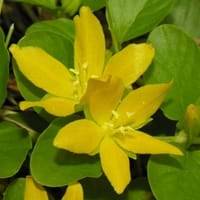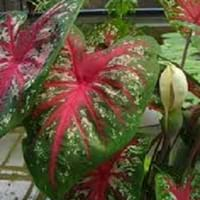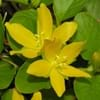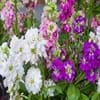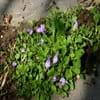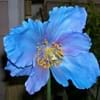Life Span
Perennial
Annual and Perennial
Type
Flowering Plants, Perennial
Tender Perennial
Origin
Europe
Southern Europe, Mediterranean
Types
creeping jenny
Not Available
Habitat
Near ponds, River side, Wet ground
gardens, Grassland, Prairies, tropical environments, Tropical regions
USDA Hardiness Zone
4-8
7-9
Sunset Zone
1a, 1b, 2a, 2b, 3a, 3b, 4, 5, 6, 7, 8, 9, 14, 15, 16, 17, 18, 19, 20, 21, 22, 23, 24
4, 5, 6, 14, 15, 16, 17, 18, 19, 20, 21, 22, 23, 24
Habit
Spreading
Mat-forming
Flower Color
Yellow
White, Green
Flower Color Modifier
Bicolor
Bicolor
Fruit Color
Not Available
Green
Leaf Color in Spring
Green
Gray Green
Leaf Color in Summer
Green
Gray Green
Leaf Color in Fall
Green
Gray Green
Leaf Color in Winter
Light Green
Light Green
Plant Season
Spring, Summer, Fall
Spring, Summer, Fall, Winter
Sunlight
Full Sun, Partial Sun, Partial shade, Full Shade
Full Sun, Partial Sun
Type of Soil
Clay, Loam
Loam, Sand
The pH of Soil
Acidic, Neutral
Neutral, Alkaline
Soil Drainage
Average
Well drained
Bloom Time
Late Spring, Early Summer
Spring, Late Spring, Early Summer, Summer, Late Summer, Early Fall
Tolerances
Drought
Drought
Where to Plant?
Container, Ground, Pot
Container, Ground, Pot
How to Plant?
Stem Planting
Seedlings, Stem Cutting
Plant Maintenance
Medium
Medium
Watering Requirements
Requires a lot of watering, Requires regular watering
Allow soil to be completely dry in between waterings, Water Deeply, Water less during winter
In Summer
Lots of watering
Lots of watering
In Spring
Moderate
Moderate
In Winter
Average Water
Average Water
Soil pH
Acidic, Neutral
Neutral, Alkaline
Soil Type
Clay, Loam
Loam, Sand
Soil Drainage Capacity
Average
Well drained
Sun Exposure
Full Sun, Partial Sun, Partial shade, Full Shade
Full Sun, Partial Sun
Pruning
Remove damaged leaves, Remove dead branches, Remove dead leaves
Cut or pinch the stems, Do not prune during shooting season, Prune if you want to improve plant shape, Prune prior to new growth, Remove deadheads
Fertilizers
All-Purpose Liquid Fertilizer
No fertilizers needed
Pests and Diseases
Pests and diseases free
fungus, Insects, Red blotch
Plant Tolerance
Drought
Drought
Flower Petal Number
Single
Single
Foliage Texture
Medium
Fine
Foliage Sheen
Glossy
Matte
Attracts
Not Available
Bees, Birds, Butterflies
Allergy
Asthma
Skin irritation
Aesthetic Uses
Beautification, Bouquets, Used for decorating walls, fences, gates, hedges, etc.
Beautification, Showy Purposes
Beauty Benefits
Not Available
Not Available
Environmental Uses
Provides ground cover
Air purification
Medicinal Uses
Diarrhea
No Medicinal Use
Part of Plant Used
Flowers, Leaves
Whole plant
Other Uses
Used as Ornamental plant
Showy Purposes
Used As Indoor Plant
No
No
Used As Outdoor Plant
Yes
Yes
Garden Design
Container, Edging, Groundcover, Hanging Basket, Mixed Border, Water Gardens
Alpine, Container, Edging, Foundation, Groundcover, Mixed Border, Rock Garden / Wall
Botanical Name
LYSIMACHIA nummularia 'Goldilocks'
CALADIUM 'Aaron'
Common Name
Creeping jenny, moneywort, herb twopence and twopenny thot
Aaron Caladium, Angel Wings, Fancy-leaved Caladium
In Hindi
Lysimachia Nummularia
Aaron Caladium
In German
Lysimachia Nummularia
Aaron Caladium
In French
Lysimaque nummulaire
Aaron Caladium
In Spanish
Lysimachia nummularia
Aaron Caladium
In Greek
Λυσιμαχία nummularia
Aaron τροπικό φυτό
In Portuguese
Lysimachia nummularia
Aaron Caladium
In Polish
tojeść rozesłana
Aaron Caladium
In Latin
Lysimachiam nummularia
Aaron Caladium
Phylum
Tracheophyta
Tracheophyta
Class
Magnoliopsida
Liliopsida
Order
Ericales
Alismatales
Family
Primulaceae
Araceae
Genus
Lysimachia
Caladium
Clade
Angiosperms, Asterids, Eudicots
Angiosperms, Monocots
Tribe
Not Available
Not Available
Subfamily
Not Available
Aroideae
Number of Species
Not Available
Not Available
Season and Care of Lysimachia Nummularia and Aaron Caladium
Season and care of Lysimachia Nummularia and Aaron Caladium is important to know. While considering everything about Lysimachia Nummularia and Aaron Caladium Care, growing season is an essential factor. Lysimachia Nummularia season is Spring, Summer and Fall and Aaron Caladium season is Spring, Summer and Fall. The type of soil for Lysimachia Nummularia is Clay, Loam and for Aaron Caladium is Loam, Sand while the PH of soil for Lysimachia Nummularia is Acidic, Neutral and for Aaron Caladium is Neutral, Alkaline.
Lysimachia Nummularia and Aaron Caladium Physical Information
Lysimachia Nummularia and Aaron Caladium physical information is very important for comparison. Lysimachia Nummularia height is 510.00 cm and width 60.00 cm whereas Aaron Caladium height is 30.50 cm and width 30.50 cm. The color specification of Lysimachia Nummularia and Aaron Caladium are as follows:
Lysimachia Nummularia flower color: Yellow
Lysimachia Nummularia leaf color: Green
Aaron Caladium flower color: White and Green
- Aaron Caladium leaf color: Gray Green
Care of Lysimachia Nummularia and Aaron Caladium
Care of Lysimachia Nummularia and Aaron Caladium include pruning, fertilizers, watering etc. Lysimachia Nummularia pruning is done Remove damaged leaves, Remove dead branches and Remove dead leaves and Aaron Caladium pruning is done Cut or pinch the stems, Do not prune during shooting season, Prune if you want to improve plant shape, Prune prior to new growth and Remove deadheads. In summer Lysimachia Nummularia needs Lots of watering and in winter, it needs Average Water. Whereas, in summer Aaron Caladium needs Lots of watering and in winter, it needs Average Water.
